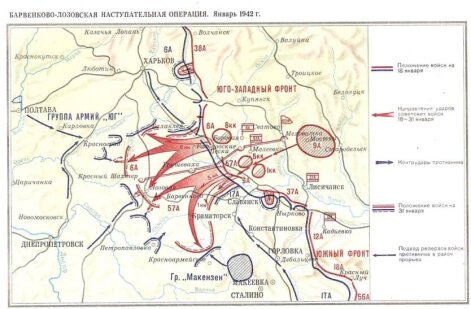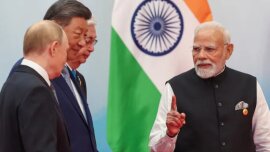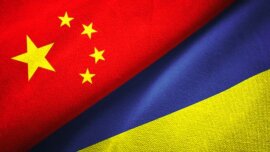At the moment, the Ukrainian-Russian war is far from being over, but it is finally now possible to make the first historical and strategic review of this largely fateful confrontation for the world order.
First of all, it should be noted that there is a certain logical orientation in the actions of the military and political leadership of Russia. In general terms, we can talk about the following formula: the first phase of the war, which lasted from the end of February to the end of March this year, became for Russia a period of constant accumulation of mistakes that led its military and political leadership to the need to limit the geographical scale of its own military efforts; as a result, the beginning of April was marked by the opening of In other words, there was a reduction of a long frivolous jump to the contours of a limited massive offensive.
This transformation is noteworthy that the miscalculations of the Russian command form a very harmonious semantic chain, the identification of which is not only of interest from the point of view of military history and the very art of strategy but also allows to develop of cautious hypotheses regarding the further nature of the actions of Russian troops.
First of all, let's consider the development of the Russian offensive in the first period of the war. It crashed on the elastic defense[1] of such cities of Ukraine as Mykolaiv, Kharkiv, Akhtyrka, Sumy, Chernihiv, and Kyiv. To top it off, the Russians got bogged down in fierce battles for Mariupol and in the Donbas region. Nevertheless, Russian troops managed to occupy Northern Tavria and most of Luhansk region; create bridgeheads in the east of Kharkiv region and right-bank Dnieper parts of Kherson region. If we talk about Sumy, Chernihiv, Kyiv, and Mykolaiv regions, there was only temporary penetration into Ukrainian territory, which eventually ended with the retreat of Russian troops. In general, the Ukrainian defense concept resembles the one used by the German command to repel the Soviet counteroffensive of December 1941 - April 1942: the Red Army managed to advance more than 250 km in certain parts of the front, but the German forces entrenched in the bastion cities (Shlisselburg, Novgorod, Rzhev, Vyazma, Bryansk, Orel, Kurs, Kharkiv, and Taganrog) prevented their success[2]. Attempts by Soviet troops to break the defense of these full-fledged fortresses, which were also strategically important transport arteries, did not lead to any positive results. Moreover, the units of the Red Army advancing between these cities put themselves at risk of encirclement, as the Germans were able to strike on their flanks[3].
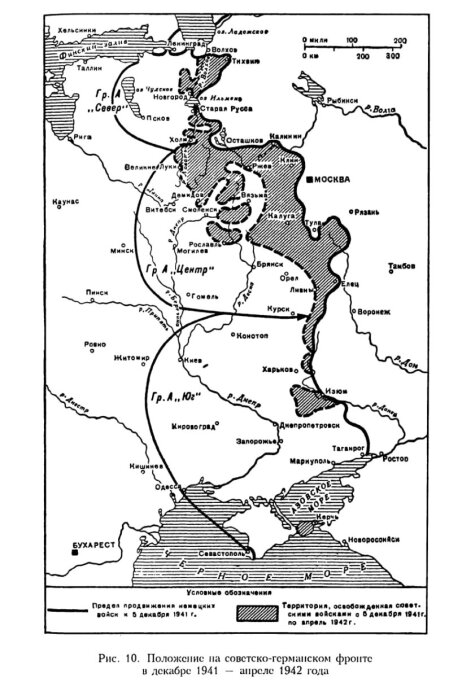
In the context of the experience of the winter of 1941-1942, there is also a similarity between Ukrainian and German tactics. Following the principles of the mentioned elastic defense, Ukrainian troops did not focus on holding long sections of their country's territories, but, using their knowledge of the terrain, information superiority over the enemy[4] and skillfully using advanced types of weapons, mobility reacted from their strongholds to the offensive actions of Russian troops. Organization of ambushes on the route of the enemy; retreat from the occupied positions to create conditions for a successful counterattack; effective artillery and aviation suppression of the enemy; raids in the enemy's rear - all this led to the stoppage of the Russian offensive during the first phase of the war. The actions of German troops were also comparable, who also acted from their fortified points when repelling the breakthroughs of the Red Army. General Günter Blumentritt's comments are indicative in this regard: "New weapons and improvements in automatic small arms partially explain the possibility of holding a wider front. Another reason was the increased mobility of protective equipment. If the attackers broke through the front, small units of tanks and motorized infantry often counterattacked and stopped them before they had time to develop penetration"[5].
In addition, like German troops in December 1941 - April 1942, Ukrainian units in February-March 2022 confirmed the principle that the success of the city's defense is determined at the initial stage of fighting when the defenders must overcome the shock caused by the awareness of the possibility of their death under siege[6]. Although the Russian effect of a full-scale invasion was supported by the blockade of Ukrainian cities, it could not shake Ukrainian troops in their readiness to continue the fight. The fierce battles for Mariupol, Kharkiv, and Chernihiv most clearly prove the legitimacy of this judgment.
All of the above allows us to conclude that the underestimation by Moscow strategists of the intellectual and moral abilities of the enemy led to an incorrect definition of the geographical scope of the offensive and the centers of military efforts. As a result, the offensive impulse of liquid "Russian blitzkrieg" recklessly rushed directly to the system of Ukrainian bastion cities. Naturally, with such irrationality of Moscow, the critical first week of the confrontation could not bring Ukraine out of balance, since the ill-considered Russian raid was opposed by the synthesis of strategic literacy of the Ukrainian command, the tactical skill of the Ukrainian soldier, the technical equipment of the Ukrainian army (albeit quite limited), as well as the will to resist the entire Every new day of invasion played against Russia - as the unsuccessful assault operations continued, firstly, the myth of the strength of the Russian army was dispelled, which automatically strengthened the confidence of the defenders in their success; secondly, an international reaction to the aggressive actions of the occupier state developed, which led Russia to a state of isolation; thirdly, the power of Ukraine fueled by allied supplies increased. Moscow's attempts to rectify the situation by organizing "moral bombing"[7] of Ukrainian cities did not bring proper results.
As a result, by the end of March, Moscow had finally lost control of its special operation: Blitzkrieg failed, demoralized Russian soldiers began to degenerate to the level of war criminals, and the atmosphere of Stalin's purges of 1937-1938 began to reign in the Kremlin.
Thus, the first stage of the Ukrainian-Russian war completely obeyed the thesis of Captain Basil Liddell Garth: "Force is a vicious circle, or rather a spiral if the use of force is not controlled by careful sound calculation. Therefore, the war, which begins with the denial of reason, comes to its approval in all phases of the struggle"[8]. From the end of February to the end of March this year, the general nature of the actions of Russian troops rested on banal recklessness - a result of Moscow's belief in the hypnotic power of the aggressively crushing image of Russia. The clash with Ukrainian rationality significantly sobered up the Kremlin. Therefore, the contours of the second stage of the war began to be set by the principles of reasonableness.
Indeed, from late March-early April, Moscow began to focus its military efforts on those areas where it managed to achieve the most favorable strategic situation for itself - the successes of Russian troops in Northern Tavria, Luhansk region, and certain regions of Kharkiv region created an opportunity for an operation to encircle Ukrainian troops in Donbas.
Let's note one very entertaining moment along the way. Part of this Russian plan was published on the pages of Khvili back in July 2015. The article "Scenario of the Kharkiv Offensive Operation of Russia" pointed out that the interfluves of Seversky Donets and Oskol can be used as a bridgehead (in the publication it was called "Velikoburluksky") for a limited offensive on Kharkiv and the rear areas of the Joint Forces Operation. In the first case, an important role was assigned to establishing control over Chuguev, in the second - over Izyum. The successful implementation of this operation, as explained in the essay, would allow Russia to take a strong position in negotiations with Ukraine. To be fair, we add that there were errors in the plan presented 7 years ago (for example, the course of the offensive in the Luhansk region was quite vaguely outlined), but on its basis, it quite accurately described the development of Russian invasion in the eastern parts of Kharkiv region in February-April 2022.
Moreover, there are some reasons to believe that Russia's special operation was originally thought of within the borders of the South and East of Ukraine. Ideally, the Velikoburluk bridgehead was to become, in the language of Archduke Karl Teshensky, a decisive point (entscheidenden Punkt), the concentration of superior Russian forces on which could lead to the defeat of the Ukrainian group of troops in the Donbas area and, as a result, to the conclusion of a new peace treaty between Moscow and The proposed operation was to develop almost according to the same scenario as in February-March 2022, but without invasion of Kyiv, Chernihiv, Sumy and Mykolaiv regions. Such a restriction on the scale of the clash would reduce the reaction of the world community and the population of Ukraine. Moreover, the successful outcome of the daring maneuver of Russian units could drive a wedge between the Ukrainian public and the Ukrainian government, as well as contribute to strengthening Russia's military and political authority.
It should be recognized that the success of the above plan required truly surgical skill - in the realities of the limited conflict of the XXI century, we are talking about a range of works from the global information campaign to discredit the enemy to the special tactical and technical training of assault groups. However, Moscow voluntarily or involuntarily abandoned such methodical planning. Therefore, Ukraine faced an enemy, whom in 1904 Infantry General Mikhail Dragomirov certified as "something".
Here we return to the triumph of the Liddell Garth principle. Ultimately, common sense took its toll: faced with the system of bastion cities, the Russian command was forced to move the center of gravity of the confrontation to the direction where the geographical conditions of the steppe area and the absence of the need to conduct exhausting deconcentrated battles for large settlements scattered along the front allowed it to implement the presented relational maneuver[9]. This measure was frankly belated: the effect of unexpected swiftness was hopelessly lost, as Russian troops, although they managed to reach the river in early March. Seversky Donets, but got bogged down in the Izyum district for a month. It is obvious that in such a situation, the Ukrainian command had enough time to develop countermeasures. Hence, from the logically follows Moscow's desire to accumulate strength for a "decisive blow" from the first days of April - they want to compensate for the obvious leveling of the factor of surprise with a massiveness factor. But a natural, key question arises at the present historical moment: will Russia be able to conduct a successful offensive in Donbas under such conditions?
The problem is that the area of current Russian military efforts can be called a place of catastrophes of World War II - the fruitless offensive operations of Soviet strategists claimed the lives of hundreds of thousands of people. Everyone was killed - both ordinary soldiers and generals[10].
In January 1942, during a large-scale Soviet counteroffensive, in the area of the river. Seversky Donets underwent the Barvenkov-Lozov operation, which aimed to enter the rear of the Donbas group of German troops. Then, in May of the same year, the bridgehead occupied by the Red Army during the January battles was used for a failed offensive on Kharkiv, which eventually ended with the so-called "Barvenkovsky Trap" surrounded by the bulk of the advancing Soviet troops. In January 1943, the USSR command again decided to encircle the Donbas group of Germans (Operation "Jump") - and again in February-March, Soviet troops were stopped and then pushed back to the river. Seversky Donets with master countermeasures of the German command. In July 1943, another unsuccessful Izyum-Barvenkov offensive for the Red Army followed, and only in September did Soviet troops manage to liberate Donbas.
Perhaps this is a simple coincidence, or perhaps we have witnessed the rock of History, but the positions occupied by Russian and Ukrainian units in the area of the river. Seversky Donets seems to refer us to the Soviet-German front on the eve of the Barvenkov-Lozov operation of January 1942. Therefore, it makes sense to dwell on its consideration in more detail.
Planning the offensive, the Soviet command decided to throw the troops of the South-Western and Southern Fronts into the space between Balakleya and Artemovsky (now Bakhmut) - the offensive had to rush straight to Zaporizhzhia. As mentioned above, she also thought about going to the rear of the Donbass-Taganrog group of German troops - the headquarters of the Supreme High Command wanted to cut off the ways of retreat to the west, and then press it against the Sea of Azov and smash it. More specifically, the operation was as follows. The Southwestern Front under the command of Lieutenant General Fyodor Kostenko, consisting of the 38th and 6th Armies, as well as the 6th Cavalry Corps, was to advance on Bogodukhov and Krasnograd, thus guaranteeing an operation from the north-west and creating conditions for the secession of Kharkiv. The tasks of the Southern Front under the leadership of Rodion Malinovsky were to strike the main blow in the direction of Pavlograd by the forces of the 57th and 37th Armies, supported by units of the 1st and 5th Cavalry Corps. The tasks of the 12th Army were charged with an attack on Dzerzhinsk (now Toretsk), and the 18th and 56th Armies were charged with covering the Kamensky and Rostov directions. The 9th Army and the 2nd Cavalry Corps formed a reserve in the South-West direction[11].
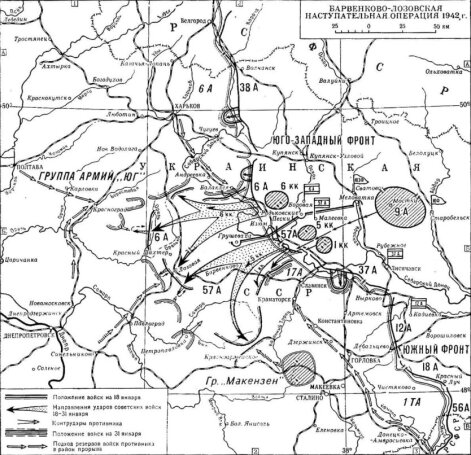
The offensive began on January 18: In the first days, the German front was broken through in the section from Balakliya to Sloviansk. On January 24, Barvenkovo was captured and on the same day the Soviet command decided to develop a strike on Krasnoarmeyskoye (now Pokrovsk) by the forces of the 57th and 37th Armies, as well as On the same day, the Headquarters of the Supreme High Command approved a plan to introduce the 9th Reserve Army into battle (the area of the junction of the 57th and 37th Armies), as well as to capture Kharkiv by units of the 38th and 6th Armies; it was also ordered to cut off enemy communications in the area of Sloviansk-Chistya Interestingly, Moscow even considered it possible to continue moving to the shores of the Dnieper and the Sea of Azov. The next day, January 27, Lozovaya was occupied by Soviet units from the 6th Army and the 6th Cavalry Corps, but they failed to develop further success. The 9th and 37th armies also made failures, which tried to defeat the German group in the area of Sloviansk-Artemovsk (Bakhmut). Units of the 57th Army and the 5th Cavalry Corps achieved some other results - they managed to create a real threat to German railway communications along the lines Pavlograd-Krasnoarmeyskoye (Pokrovsk), Sinelnikovo-Chaplino-Krasnoarmeyskoye (Pokrovsk). Nevertheless, the stubborn defense and counterattacks of the Germans led to the fact that on January 31 the Soviet offensive ended, and in February-March, there was a stabilization of the front[12].
Thus, the initially large-scale Soviet breakthrough to the Dnieper and the Sea of Azov developed only to the ledge between Balakleya, Lozova, and Slavic depths of 90 km and the front up to 110 km[13].
Frankly speaking, the results of the Barvenkov-Lozov operation created more problems for the Soviet command than advantages. As the experience of the Kharkiv disaster of May 1942 showed, the bridgehead captured by the Red Army during the January battles was unsuitable for successful offensive actions. The reason for this mainly lies in the fact that the Soviet troops failed to capture Balakliya and Sloviansk - important strongholds of the German army, which were used as part of Operation Fredericus to organize the Barvenkovsky Cauldron.
Now in the area of the river. Seversky Donets Russian troops occupy the pre-advancing January positions of the Red Army, while Ukrainian units found themselves in the position of German forces. The difference is in the following important details: Balakleya is under Russian control; the Ukrainian positions near Sloviansk and Lysychansk are moved deeper than the German ones in 1942 (Soviet troops held Krasny Liman and Lysychansk, and from the second front was moved to Nyrkovo and Dronovka); the Ukrainian-Russian front south of the created ledge is significantly different from the German-Soviet one since the latter in January 1942 passed along the river Mius.
It should be noted that it is the factor occupation of Northern Tavria and the southern parts of the Donetsk region that creates at first glance favorable conditions for the Russian offensive, which the Red Army did not have in January 1942. We are talking about the repetition of the Soviet plan with the noticeable difference that the tasks of encircling Ukrainian troops in Donbas will be assigned to several strike groups at once - northern, Izium-Balakley, and southern, Maryinsky-Novoselkovsky. Their key task is to cut off the communications linking the Donetsk ledge with the rear areas of the Joint Forces Operation and create conditions for the defeat of the surrounded Ukrainian troops.
Previously, the Izium-Balakley group should level the front, occurring Gusarovka and Petrovskoye, and then capture Grushevakha and Velikaya Kamyshevakha with converging strikes from the north and northeast. After that, the attacking Russian forces will move to Barvenkovo, from where they will move to capture Aleksandrovka on the river. Samara. Thus, the way to the western regions of Sloviansk and Kramatorsk will be opened - with simultaneous attacks from Izyum and Liman, this situation will create a serious burden on the defending Ukrainian troops. In the future, if there are sufficient resources in manpower and equipment, it is possible to develop a Russian offensive to Dobropol and Pokrovsk to connect with the Maryinsky-Novoselkovsky group of troops. Thus, the maneuver of the 5th Cavalry Corps and the 57th Army of January 1942 will be repeated.
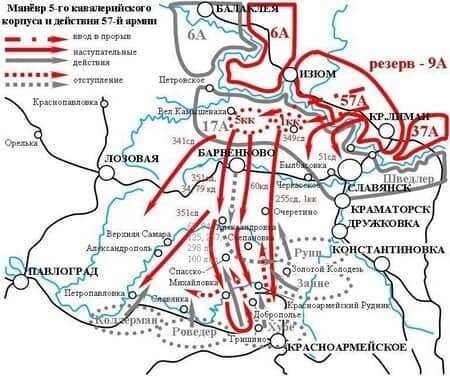
The question remains whether Russian units will advance from Balakliya to Zmeiniy. The idea of gaining control over the junction of the front in the area of the Gomolshan forests looks very attractive, but there is a high probability that Ukrainian troops, like the Germans in 1942, made this sector impregnable. Therefore, its assault will lead to a significant weakening of the offensive abilities of Russian units. The possibility of catching Lozova's by Izyum-Balakley group is also questionable, as the 6th Army and the 6th Cavalry Corps did in January 1942 - the operational lines of the offensive of Russian units pose a limited threat to the city, the rear of which, in addition, is guaranteed by communication with Pavlograd.
As for the Maryinsky-Novoselkovsky group, its task is to conduct an offensive on Velikaya Novoselka with a subsequent exit to Andreevka and Alekseevka on the river. Wolf. wolf. The further goal of the Russian troops is Pokrovsk and connection with strike units from the northern group in Dobropillya. It should not be ruled out that Russian units will attack Novopavlovka, Mezhevoye, and Slavyanka from Alekseevka. Let's add one more detail: to deter Ukrainian units, the advance to Pokrovsk will be accompanied by an intensification of battles at Ugledar, Maryinka, Sand, and Avdiivka.
Regarding the operations in Northern Tavria, it can be said that particularly fierce fighting will unfold for Gulyaipole, as this point is the most important from the point of view of the prospect of further attack on the “Chaplino” railway station. In addition, clashes in this direction will constrain Ukrainian units, which, for example, could be involved in other parts of the front.
Such a plan, however, is good only on paper: like the offensive of the Red Army in January and May 1942, Russia's current operation, having achieved incomparable results, can create all the necessary conditions for the defeat of its troops. The lesson in the history of the Eastern Front of World War II is that if you want to successfully advance in the area of the river. Seversky Donets, you need to first of all focus your efforts on the capture of Kharkiv and its agglomeration. There is an extremely simple principle: take a closer look at the map of hostilities, and you will see a kind of staircase leading from this city to Donbas. The height of its step is the front of defending Ukrainian and, in the past, German troops. Accordingly, if the enemy wants to avoid flank strikes from a higher stage, he must spend his energy on getting rid of the "ladder principle", logically coming to the need to level the front by capturing Kharkiv or at least turning such located on the river. Northern Donets of cities like Pechenegs, Chuguev, and Snakes in bastions. Meanwhile, the Russians have not fulfilled this condition and do not seem to comply with it. On the contrary, following the logic of the "ladder principle", Ukrainian troops over the river. Seversky Donets is already conducting successful counterattacks.
It follows that attempts of the Izyum-Balakley group of Russia to seize Gusarovka, Velikaya Kamyshevakha, Barvenkov, Aleksandrovka, and Izyum can be met with flank blows of the Ukrainian reaction forces. If the Russian command wants to protect its troops from such a scenario, it will have to conduct an offensive in the area between the river. Seversky Donets and r. Bereka in the direction of Pervomaisky, Krasnopavlovka and Nadezhda. There will be a return to the "ladder principle", as the right flank of the attackers will rest against the area of the Gomolshan forests and Zmiev, from where counterattacks by Ukrainian troops may follow. The trap of the current situation is obvious: the Russian command is forced either to put its northern attack group under attack from the right flank and rear (a repetition of the Kharkiv catastrophe of May 1942 is planned), or, in the hope of ensuring its security, to crush its forces to capture new defensive lines located in the way of possible counterattacks of Ukrainian troops. In two cases, there are prospects for the collapse of the Russian offensive - a colossus on clay legs.
If we take into account the experience of fighting in Donbas in late 1941 - early 1942, we can assume that Russia's operation in April 2022 will face an extensive system of Ukrainian strongholds along the entire front. Their assault, especially the fort cities of the Donbas ledge, will slow down the advance of the advancing troops and provide the command in Moscow with high losses in manpower and equipment. According to the memoirs of German officers, it was the transformation of each town or village into Schwerpunkt, with prepared fortifications equipped with artillery positions[14] and minefields, that allowed the Germans to contain the onslaught of Soviet troops. If any units of the Red Army still managed to penetrate the defensive zone, they were destroyed by artillery strikes or bold counterattacks. This is the meaning of active defense, which is widely used by the Ukrainian army in the war with the Russians. Therefore, there is every reason to believe that the offensive of Russian troops, even if it can make a gap in the Ukrainian defense, will still not create a critical position at the front.
In conclusion, we note that the war between Ukraine and Russia has come a largely indicative way from an arrogant, devoid of sanity to the only logically acceptable massive offensive in the created conditions. Russia's April Offensive is a typical Soviet operation taking place on lands where the attacking impulses of the Soviet command collapsed. The upcoming battle will be a test for two clashing armies, but the inexorable logic of history and its mother geography gives Ukrainian troops a chance to gain a well-deserved victory in the great steppe battle of the XXI century.
Footers
[1] Back in 1918, this method was successfully used by General Philippe Petin. His idea involved the possibility of absorbing the first onslaught of the enemy due to the concentration of forces not on the front lines of defense, but in the depths of the rear areas. Thus, saving the manpower of the French army was achieved. For more details, see Лидделл Харт Б. История первой мировой войны. Лондон: Papermac, 1992. P. 416.
[2] Liddell Hart B. История Второй мировой войны. Нью-Йорк: Putnam, 1971. P. 241.
[3] Ibid. P. 242.
[4] This implies the use of UAVs and obtaining information about the movement of Russian troops from the local population.
[5] Liddell Hart B. Другие стороны холма. Лондон: Cassell & Co Ltd. P. 201-202
[6] Liddell Hart B. История Второй мировой войны. P. 242
[7] The term was introduced by Hans Rumpf to define a method aimed at undermining the morale of the population. For more details, see Rumpf H. Bombing of Germany. Нью-Йорк: Холт, Ринехарт и Винстон. P. 179-180.
[8] Liddell Hart B. Стратегия. New York: Meridian. P. 357.
[9] For more details, see Luttwak E. Стратегия: logic войны и мира. Cambridge, Лондон: The Belknap Press of Harvard University Press. P. 93-94.
[10] In May 1942, the commander of the Southwestern Front, Lieutenant-General Fedor Kostenko, went missing in the Barvenkovo area. At the end of April 2017, his remains were found in the area between the villages of Gusarovka and Lozovenka. The ashes of the military commander were solemnly reburied in the Russian Pantheon of Defenders of the Fatherland.
[11] History of World War II 1939-1945 Volume 4: Fascist aggression against the USSR. The collapse of the lightning war strategy. Moscow: Military Publishing House of the Ministry of Defense of the USSR. Village 319–320.
[12] Ibid. Village 320–321.
[13] Ibid. Village 321.
[14] It is undeniable that the artillery will play one of the main roles in repelling Russia's April offensive due to fighting mainly in open steppe terrain.
